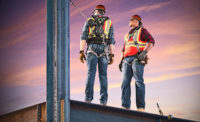Company executives need to be persistent about instilling safe and healthy habits in their employees. Given the dangerous nature of performing industrial tasks, it is concerning to hear that many workers will bypass safety equipment that is designed to protect them. The best way to change worker apathy toward fall protection systems is through the use of a well-designed training program. Even though workers will be the most directly influenced by falling at work, it is also important for the corporate side of an industrial company to be safety conscious.
Benefits for the bigwigs
Executives may argue that fall protection systems do not apply to people of their status. However, fall protection systems have a large impact on the core of industrial workers. First and foremost, investing in a quality fall protection system will save the company thousands (if not millions) of dollars over time. Even though OSHA citations are not cheap, some employers feel that fines are cheaper than paying for a quality fall protection system. But a company will be more profitable if lawsuits, fines and increased insurance rates are not contributing to corporate deficit.
Amidst financial concerns, corporations may lose sight of the hidden benefits associated with the use of fall protection systems. The use of a quality fall protection system allows for a more efficient work zone with active fall protection systems. If workers can get into their protection gear quickly and can use it easily while on-site, those workers are more likely to accomplish a task in a quick and safe manner. If a worker falls while on a job, many hours are spent dealing with the aftermath. Typically, fewer injuries mean workers will have higher morale. If workers are happier and safer at their jobs, then the company gains a positive reputation in the community for providing a safe work environment.
A safety presence
Since it can be difficult to enforce the utilization of safety equipment, there are a few different ways that a company can approach this problem. Every hazardous work zone should have some form of safety team/committee. Having a team of people who will function as safety coordinators allows the company to have its own safety monitoring system. There will be far fewer accidents thanks to the presence of a higher level of enforcement.
Even though it is not an official requirement, it is a good idea to have informational posters available. Posters are a good way to remind people about the protocols of the office as well as how the equipment is used. Posters also provide a constant reminder of the company’s desire for workplace safety. And one of the best ways a company can encourage their workers to use safe habits in the workplace is to offer different benefits for being safe. For example, if the safety committee consistently documents that an individual is always using their safety equipment, that individual could be rewarded in some way. Giving public accolades for safe behaviors is one way to encourage workers, in addition to giving money or treating them to a nice lunch.
Facing fall protection issues
In some instances, a workplace will provide all of the things mentioned here, but still, workers may not practice appropriate procedures. In those situations, it is important to address the specific reasons why workers are not using their equipment. The most common complaint with fall arrest systems are that applying harnesses and planning for fall protection is a waste of time. Meanwhile, some workers complain that the actual harnesses are uncomfortable to wear. And unfortunately, there are some instances where the harness can impede work. The nice thing about all of these issues is that they are being resolved through the same source: harness manufacturing design teams.
Harness designers are developing new technology for workers all the time. The newest designs for harnesses are easier to wear, more comfortable and less dangerous than the older designs. Companies should strive to purchase the newest models of harnesses and other personal protective equipment to ensure the safety and comfort of employees. It is imperative that workers, safety committees and executives communicate with one another about the issues they face with fall protection equipment. If a worker does not like the equipment they are given, they will be less likely to use that equipment, regardless of their circumstances.
Training talk
Training sessions can be immensely helpful in regards to helping executives and employees understand the importance of using fall protection systems in hazardous work environments. Many different topics are covered during training sessions, but a quality fall protection presentation will find a positive and interesting way to explain the importance of maintaining safety in the workplace. Amusing pictures and videos of precarious situations or unusual workplace falls are a good way to show the importance of having a fall protection system. It is important that fear is not used as a means of encouraging workplace safety unless an employee has shown that they require that approach.
A well-developed training session should describe the different outcomes for a worker after a fall to encourage them to use fall protection. Between hospital bills, disability leave and having fewer hours at work, a fall can result in some serious financial changes for workers. After financial costs, training should mention that falls can reduce the quality of life for the worker and the lifestyles of friends and family. A well-rounded training session should include information about new technology in the world of fall protection.
Be proactive about protection
There are more benefits than deficits in regards to employing workplace fall protection systems. Corporations will save money, gain an image of safe and upbeat workers in the community, and the business itself will become more efficient. Meanwhile, employees will have a better quality of life, should they experience a fall, and the employees may be rewarded for being safe. Ultimately, it is important to remember the goal of fall protection systems: reducing the number of fall-related injuries and fatalities in the workplace. Be proactive about protection; it pays off.


